New breakthrough: This collagen can make tumor cells go dormant!
- Normal Liver Cells Found to Promote Cancer Metastasis to the Liver
- Nearly 80% Complete Remission: Breakthrough in ADC Anti-Tumor Treatment
- Vaccination Against Common Diseases May Prevent Dementia!
- New Alzheimer’s Disease (AD) Diagnosis and Staging Criteria
- Breakthrough in Alzheimer’s Disease: New Nasal Spray Halts Cognitive Decline by Targeting Toxic Protein
- Can the Tap Water at the Paris Olympics be Drunk Directly?
New breakthrough: This collagen can make tumor cells go dormant!
- Should China be held legally responsible for the US’s $18 trillion COVID losses?
- CT Radiation Exposure Linked to Blood Cancer in Children and Adolescents
- FDA has mandated a top-level black box warning for all marketed CAR-T therapies
- Can people with high blood pressure eat peanuts?
- What is the difference between dopamine and dobutamine?
- How long can the patient live after heart stent surgery?
New breakthrough: This collagen can make tumor cells go dormant!
Tumor metastasis is the leading cause of death in cancer patients and an important challenge for oncologists.
After the primary tumor is removed, if the residual tumor cells cannot be completely removed by postoperative adjuvant therapy, these tumor cells will reach distant organs through the blood circulation, colonize and enter a dormant state.
After several years, the dormant tumor cells will be activated by specific conditions. Proliferate rapidly and form obvious metastases.
Once the tumor cells enter dormancy, the cell cycle is stagnant in the G0/G1 phase, and the cells do not proliferate or apoptose.
Traditional radiotherapy and chemotherapy will lose their effect, making it more difficult to completely cure the tumor.
Therefore, some scholars have proposed that it can be activated Dormant tumor cells will be wiped out.
The problem is that the gene expression of dormant tumor cells and primary tumor cells is different. The original treatment plan may not work on the activated cells. Hastily activating dormant tumor cells may cause worse condition
Therefore, another group of scientists decided to do the opposite. Either let this batch of dormant tumor cells dormant permanently to prevent them from awakening, or even more ruthlessly, while they are dormant, directly annihilate them, which may prevent tumor recurrence. .
To make tumor cells dormant, it is necessary to understand the mechanism of their dormancy.
A research team from the Icahn School of Medicine at Mount Sinai, USA, recently published a study in Nature Cancer, revealing the key role of the extracellular matrix in the tumor microenvironment for tumor cells to enter and maintain a dormant state.
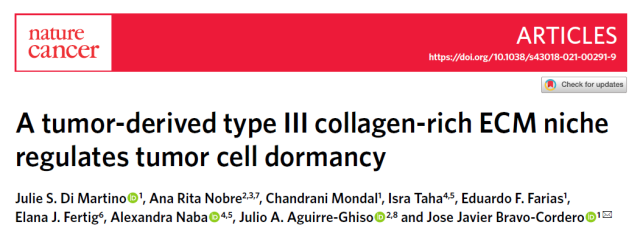
The researchers first started from the nest of dormant tumor cells to explore what is so special about this tumor microenvironment that can make tumor cells sleep here?
Dormant tumor cell lines and proliferative tumor cell lines were inoculated into mice by tail vein injection.
Unlike proliferative tumor cells that rapidly form tumors in mice, dormant tumor cells usually appear as single cells in mice. In the form of cells or indolent nodules.
Under multiphoton second harmonic imaging, the researchers observed:
Dormant tumor extracellular matrix is mainly composed of coiled, disorganized collagen fibers, while proliferating tumor extracellular matrix collagen fibers show a straight, more directional linear arrangement.
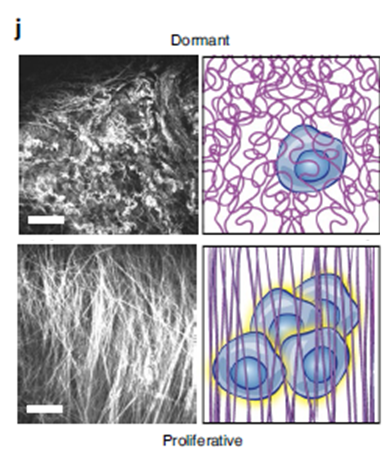
Legend: Domant dormant; Proliferative proliferation
As the tumor progresses, the arrangement of collagen fibers in the tumor extracellular matrix also undergoes dynamic changes.
The more advanced the tumor develops, the more tidy the curled collagen fibers become.
What’s even more amazing is that when the researchers inoculated the proliferative tumor cells in the mice, the tumor was surgically removed to simulate the clinical treatment of patients with tumor surgery.
There are a small number of residual tumor cells at the edge of the surgical wound. When these residual tumor cells recur in situ or in distant metastasis, and enter a proliferating state from a dormant state, the collagen fibers around the cells also undergo a change from curling to straight.
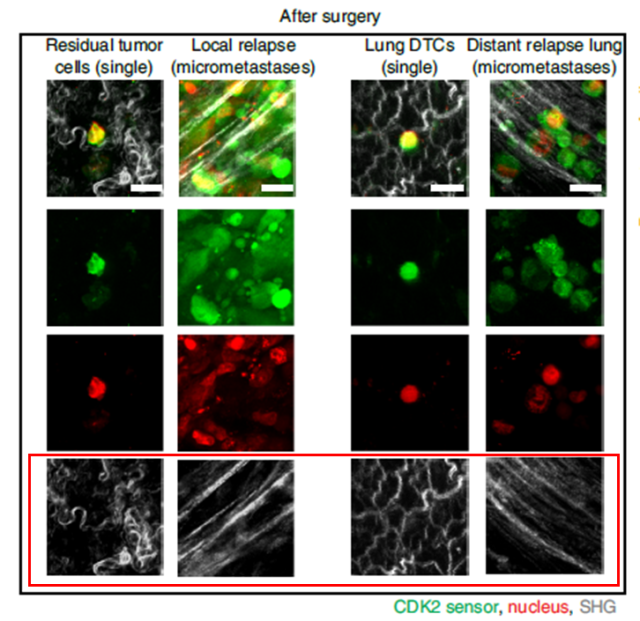
Legend: Left: tumor recurrence in situ Right: tumor lung metastasis recurrence
These results together indicate that the structure of the extracellular matrix is closely related to the dormant-recovery state of tumor cells.
The collagen around the dormant tumor cells is distributed in a curled manner, and once the dormant cells recover and proliferate, the surrounding collagen exhibits a linear distribution.
Further, the researchers performed mass spectrometry analysis on decellularized tumor clumps to study the compositional differences in the composition of the extracellular matrix of tumor cells in dormant and proliferating states, and found that compared with proliferating tumor cells, type III collagen in the extracellular matrix of dormant tumors was found.
The content of tumor cells was significantly increased, and the transcriptomic analysis of tumor cells also showed that the expression of COL3A1 in dormant tumor cells increased.
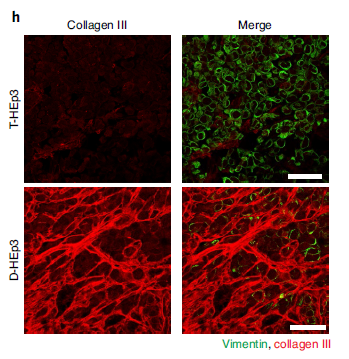
Legend: collagen type III (red fluorescence), T-HEp3 proliferating head and neck squamous cell carcinoma cell line, D-HEp3 dormant head and neck squamous cell carcinoma cell line
At the same time, biopsies of primary tumor sites in clinically head and neck squamous cell carcinoma patients showed that those with lymph node metastases had higher levels of type III collagen in the primary tumor sites than those without metastases. Low.
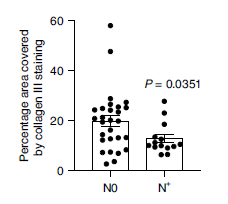
Legend: N0 tumor patients without lymphatic metastasis, N+ tumor patients with lymphatic metastasis
The above results indicate that the higher the content of type III collagen in the tumor microenvironment, the more prone to dormancy of tumor cells, and the lower the content of type III collagen, the more active the tumor cells, and the easier it is to metastasize.
In the next step, in order to prove whether type III collagen is the key for tumor cells to “stop the horse” into a dormant state, the researchers combined proliferating tumor cells with type I collagen, type III collagen, type IV collagen, Dulbecco’s phosphate buffered The solution (DPBS) was inoculated into chicken chorioallantoic membrane and found:
Tumor cells co-injected with type III collagen formed smaller tumor masses, down-regulated histone H3 phosphorylation associated with tumor cell proliferation, and increased the expression of nuclear protein p27, a dormant marker, suggesting that type III collagen inhibits tumor cells Proliferate and induce tumor cells to enter a dormant state.
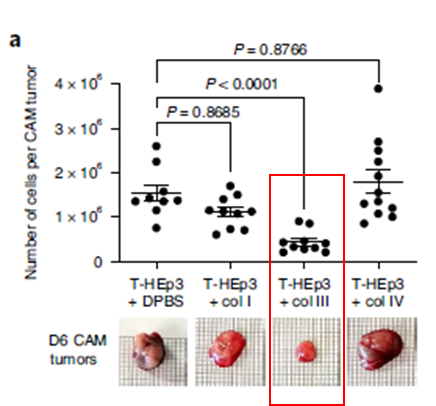
Next, in order to verify whether type III collagen can inhibit the proliferation of residual tumor cells at the resection site of the primary tumor, the researchers covered the tumor resection site with a dental sponge infiltrated with type III collagen, and the control group covered the corresponding site with DPBS infiltrated The sponge, tracked the recurrence of local tumors in two groups of mice, and found that:
Only 20% of the mice implanted with type III collagen bioscaffolds had tumor recurrence, while the control group mice had an 80% probability of tumor recurrence!
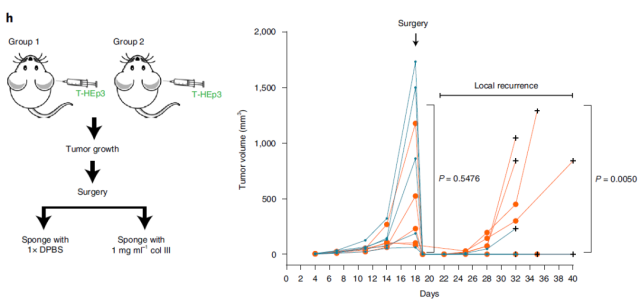
Legend: blue: collagen type III group, orange: postoperative local recurrence of tumor in DPBS group
More importantly, type III collagen not only inhibits tumor proliferation and induces tumor cells to enter a dormant state, but is also the key to maintaining a dormant state of tumor cells.
After the COL3A1 gene of dormant tumor cells is knocked out, the dormant tumor cells are no longer dormant, and rapidly proliferate and grow after implantation.
However, if the proliferative tumor cells overexpress COL3A1, the cell proliferation is inhibited, and the tumor mass formed after implantation is smaller. , again proving that type III collagen is indispensable during tumor cell dormancy.
Finally, in order to find out which signaling pathways are used by type III collagen to induce and maintain tumor cell dormancy, after a series of gene knockout and salvage experiments, the researchers found that there is a relationship between type III collagen and dormant tumor cells. Positive feedback path:
The dormant type III collagen binds to the DDR1 receptor of tumor cells, activates STAT1 into the nucleus, promotes the expression of COL3A1, and the tumor cells secrete type III collagen, and the tumor cells maintain dormancy.
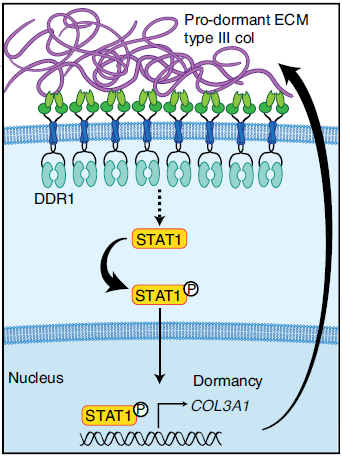
In conclusion, this study sheds light on the influence of the tumor microenvironment on tumor cell dormancy and demonstrates that collagen type III plays an important role in this study, and the addition of type III collagen to the tumor microenvironment promotes tumor cell entry and maintenance in a dormant state. , inhibit tumor proliferation.
Keeping the residual tumor cells in the body of tumor patients in a dormant state can avoid tumor recurrence and prolong the survival period of patients. The clinical trial of using “5-AZA + all-trans retinoic acid” to inhibit the recovery of dormant tumor cells in prostate cancer patients has been carried out ( NCT03572387).
In the future, type III collagen may be used clinically as a marker for predicting tumor recurrence and a therapeutic method to maintain tumor cell dormancy and prevent tumor recurrence.
(ps: Type III collagen can only play a role in promoting dormancy in the tumor microenvironment. No one thinks that oral type III collagen can fight cancer, right?)
References:
[1] Di Martino, JS, Nobre, AR, Mondal, C. et al. A tumor-derived type III collagen-rich ECM niche regulates tumor cell dormancy. Nat Cancer (2021).
[2] Sosa MS, Bragado P, Aguirre-Ghiso JA. Mechanisms of disseminated cancer cell dormancy: an awakening field. Nat Rev Cancer. 2014;14(9):611-622.
[3] Aguirre-Ghiso, J., Bragado, P. & Sosa, M. Metastasis Awakening: Targeting dormant cancer. Nat Med 19, 276–277 (2013).
New breakthrough: This collagen can make tumor cells go dormant!
(source:internet, reference only)
Disclaimer of medicaltrend.org
Important Note: The information provided is for informational purposes only and should not be considered as medical advice.



